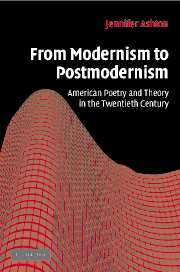Book contents
- Frontmatter
- Contents
- Acknowledgments
- Introduction: modernism's new literalism
- Chapter 1 Gertrude Stein for anyone
- Chapter 2 Making the rose red: Stein, proper names, and the critique of indeterminacy
- Chapter 3 Laura (Riding) Jackson and T=H=E N=E=W C=R=I=T=I=C=I=S=M
- Chapter 4 Modernism's old literalism: Pound, Williams, Zukofsky, and the objectivist critique of metaphor
- Chapter 5 Authorial inattention: Donald Davidson's literalism, Jorie Graham's Materialism, and cognitive science's embodied minds
- Notes
- Index
Introduction: modernism's new literalism
Published online by Cambridge University Press: 22 September 2009
- Frontmatter
- Contents
- Acknowledgments
- Introduction: modernism's new literalism
- Chapter 1 Gertrude Stein for anyone
- Chapter 2 Making the rose red: Stein, proper names, and the critique of indeterminacy
- Chapter 3 Laura (Riding) Jackson and T=H=E N=E=W C=R=I=T=I=C=I=S=M
- Chapter 4 Modernism's old literalism: Pound, Williams, Zukofsky, and the objectivist critique of metaphor
- Chapter 5 Authorial inattention: Donald Davidson's literalism, Jorie Graham's Materialism, and cognitive science's embodied minds
- Notes
- Index
Summary
MODERNISM/POSTMODERNISM
“As we move into the twenty-first century,” observes Marjorie Perloff in a recent book, “the modern/postmodern divide has emerged as more apparent than real.” Coming not only from a distinguished critic, but also the foremost academic champion of an avant-garde that – whatever disagreements its individual members have about their place in postmodernism – has defined itself against modernism, this observation is a striking one. After all, the divide once seemed crucial to many literary historians, including Perloff herself. Why now does it seem irrelevant, or perhaps more to the point, why did it use to seem so fundamental? What was the crucial difference between modernism and postmodernism? That is, what is the difference between, say, T. S. Eliot or Wallace Stevens and the poets most often identified with postmodernism, particularly those affiliated with the language movement in American poetry (Charles Bernstein, Lyn Hejinian, Ron Silliman, Steve McCaffery, Barrett Watten, Bob Perelman, Susan Howe, Michael Palmer, to name a few)? Certainly by customary definitions, the difference would seem incontrovertible. Where, for example, the modernism of Eliot has been identified with the autonomy of the text (or what postmodernism calls the “closed” text) and the determinacy of its meaning, the postmodern text is “open” and its meaning is indeterminate. And where the participation of the reader was thought to be irrelevant to the text in modernism, it has become not just relevant but crucial to the text in postmodernism.
- Type
- Chapter
- Information
- From Modernism to PostmodernismAmerican Poetry and Theory in the Twentieth Century, pp. 1 - 29Publisher: Cambridge University PressPrint publication year: 2006



